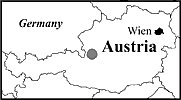 Göll
Göll
|
Piotr Tambor |
| Wielkopolski Klub Taternictwa Jaskiniowego |
 |
|
Upper entrance to Hochschartehohlensystem (in circle) ph. P. Tambor |
Göll Massif is situated in Austria, 30 kilometres south of Salzburg. It is certainly smaller than the neighbouring ones (Hagengebirge, Tennegebirge). Still, Göll is very interesting from the speleological point of view. It has already been through many years of research, aiming at recognizing the massifs insides and finding the collector by which the water is drained off to the only resurgence - Schwarzbachfall.
The exploration teams have been active there since 1989 (the period includes some discontinuities though). Yet, the systematic exploration of the Hoher Göll massif has been in progress since the beginning of the 1990s.
At the very moment the exploration is conducted by two clubs: Katowicki Klub SpeIeologiczny (KKS) and Wielkopolski Klub Taternictwa Jaskiniowcgo (WKTJ). Nevertheless, since the exploration team members originate from various clubs, it makes this enterprise an interclub one and it will remain as such.
Separate activity within this region was conducted by Sekcja Grotołazów Wrocław (Wrocław Cavers Section). The most interesting explorations have been conducted in the Hochscharte Pass region. It is there, where the most prominent success in the exploration during the recent years took place in 2001 - the connection of two caves: Gadających Kamieni "Talking Stones" and Kammerschartenhöhle into one system: The Hochschartchöhlensystem (depth of 1033 m). The exploration of this system is still in progress, however, because of the danger of falling ice (especially in Studnia Przełamanych Lodów), it has to be conducted in winter.
 |
|
By the entrance to Schartenschacht ph. Z. Rysiecki |
The second intriguing, but at the same time dangerous, cave is Schartcnschacht. Again, this cave has been explored for many years. Unfortunately, due to its many, extremely hard squeezes it can comprise only few people, which has a negative effect on the exploration speed.
In 2003 in Schartcnschacht a depth of 923 m was reached. Exploration stopped above the next pitch which is the starting point of the ongoing exploration.
Recently, the old problem of the "the uncompleted cave" has been addressed once more. Many years ago a snow plug was encountered in a cave. Finally, in 2004 the obstacle was overcome and the cave was deepened to 320 m. The exploration stopped at the bottom of the pitch below which lies another cave. The latter has a prospect of connection ![]()
